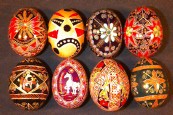Eostre
 At the time of the Vernal Equinox, eggs were used for the creation of talismans and were also ritually eaten. There is little doubt that clutches of eggs laid by many different kinds of birds in the Spring were a welcome dietary supplement to early hunter/gatherers after the sparseness of Winter. It also possible that gathering a variety of eggs from nests of birds by our ancient ancestors gave rise to two customs still popular today - the Easter egg hunt, and coloring eggs in imitation of the various pastel colors of the eggs of wild birds. It is also believed by some that humankind first got the idea for weaving baskets from watching birds weave nests.
At the time of the Vernal Equinox, eggs were used for the creation of talismans and were also ritually eaten. There is little doubt that clutches of eggs laid by many different kinds of birds in the Spring were a welcome dietary supplement to early hunter/gatherers after the sparseness of Winter. It also possible that gathering a variety of eggs from nests of birds by our ancient ancestors gave rise to two customs still popular today - the Easter egg hunt, and coloring eggs in imitation of the various pastel colors of the eggs of wild birds. It is also believed by some that humankind first got the idea for weaving baskets from watching birds weave nests.
Eostre (pronounced Es-tra) was an Anglo-Saxon goddess of Spring to whom offerings of cakes and colored eggs were made at the Vernal Equinox. Rabbits were sacred to her, especially white rabbits, and she was to believed to have taken the form of a rabbit. She was the goddess of the East, of Rebirth and of Spring.
In the Ukraine, women dye eggs in brilliant reds, yellows, and oranges. These eggs are called krashanka, and they were eaten to celebrate the rebirth of the Sun and the return of the seasons of plenty. These krashanka were closely associated with a race of “spirits” called “Kindly Ones” who dwelt in darkness of the banks of the rivers of the world. On Eostre’s Day, the red shells of the krashanka were thrown into the rivers so that they would eventually arrive on the banks of this distant island, bringing with them the message that the Sun and the Season of Rebirth have returned. Another custom was to place a krashanka on the fresh grave of a loved one assuring rebirth and return.
The Ukraine did not accept Christianity as its official religion until 988 C.E. and at that time the Pagan population refused to give up this Pagan art, so eventually the Church had to accept it, give its blessing, and call them Easter eggs.
There is an ancient legend in the Ukraine that tells of a demon monster that would devour the world. This monster is chained, and as it strains and pulls, the links of its chains strengthened in proportion to the number of pysanky that were made and exchanged that season.
A more decorative form of colored egg is the pysanky. The word “pysanky” comes from the root word psaty “to write”, because signs are written on the surface of the egg in a rich language of symbols almost endless in number and variation. The pysanky were powerful amulets that helped to maintain the balance between dark and light, death and rebirth, and for fertility and prosperity on the personal level. They were made and exchanged between friends and family during the springtime season of rebirth.